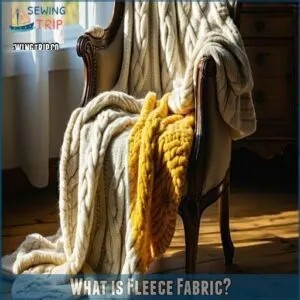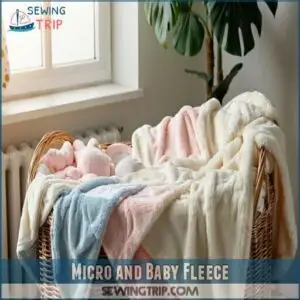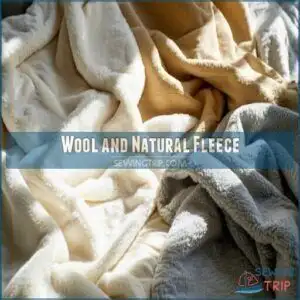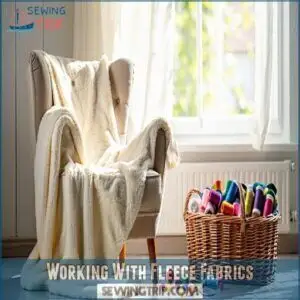This site is supported by our readers. We may earn a commission, at no cost to you, if you purchase through links.
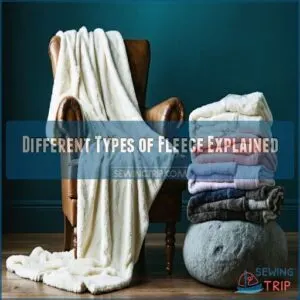
There’s polar fleece, which is soft and fuzzy, medium weight fleece, which is versatile, and micro fleece, which is smooth.
You’ll also find anti-pill fleece, baby fleece, and minky fleece, each with its own unique characteristics.
When choosing a fleece, consider its weight, texture, and intended use, and understanding the various types of fleece will help you make an informed decision, and there’s more to explore about their properties and uses.
Table Of Contents
Key Takeaways
- You’ll find various types of fleece, including polar fleece, medium weight, micro, anti-pill, and minky fleece, each with its own unique characteristics, such as softness and breathability, and durability, that suit different needs and projects.
- When choosing a fleece, you should consider its weight and texture, and intended use, as these factors will help you make an informed decision about the best type of fleece for your needs.
- You’ll discover that fleece is typically made from synthetic materials like polyester fibers, which provides warmth, breathability, and water-resistance, but you can also find natural fibers like cotton, wool, and bamboo that offer a softer, more breathable alternative.
- To get the most out of your fleece, you should follow proper care instructions, such as washing it in cold water, skipping fabric softener, and air drying or tumble drying on low, as this will help maintain its softness and warmth.
What is Fleece Fabric?
You’re about to learn what fleece fabric is, and it’s a soft material often used for clothing and blankets.
You’ll discover that fleece is typically made from synthetic materials, and it’s known for its ability to trap body heat, offering insulation, and being water-resistant.
How is Fleece Made?
Ever wonder how that soft fleece is made? Fleece production starts with fabric synthesis from polyester.
Here’s a peek into textile manufacturing:
- Yarn creation: Fine fibers are spun into yarn.
- Material processing: The yarn is woven into a base fabric.
The fleece fabric characteristics emerge as the fabric is brushed, creating the fuzzy texture of polar fleece or the smooth feel of micro fleece. This manufacturing process results in a warm, water-resistant material.
Properties of Fleece
You’ll love fleece’s properties: insulation, breathability, and water resistance.
Fleece retains heat, wicks moisture, and keeps you warm without weighing you down, thanks to its thermal retention and moisture-wicking abilities.
Making it a great choice for active wear with its fabric properties and insulating properties.
Polar and Medium Weight Fleece
When looking into fleece insulation, consider polar fleece and medium weight fleece for warmth and durability.
For ideal results, learn about proper fleece sewing techniques.
- Medium weight fleece is versatile
- Polar fleece is soft and fuzzy
- Anti-pill fleece reduces pilling.
Polar fleece is a popular winter fabric, made from polyester, and is available in different weights.
Medium weight fleece works well for projects like blankets, jackets, and hats, requiring both warmth and fleece durability.
Polar fleece is a great choice for winter fabrics, offering the benefits of medium weight fleece and anti-pill properties, making it a practical option for various applications.
Micro and Baby Fleece
You’ll find micro fleece softer and thinner than polar fleece, making it perfect for baby clothing and blankets.
Polar fleece is a versatile polyester fabric used in various clothing items.
Micro fleece layers well, breathes easily, and has soft textures. As a breathable material, it’s great for baby blankets.
When choosing micro fleece, check the fabric content, as some may stretch permanently or lack warmth. Micro fleece is a type of micro fabric, and when compared to micro polar fleece, it’s a great option for those seeking lightweight, breathable materials, making it one of the best types of fleece fabric for baby blankets and clothing.
Minky and Cuddle Fleece
You’re working with Minky and Cuddle fleece, known for their soft, plush texture.
- They offer a luxurious feel, like mink fur.
- They can be tricky to sew due to their slippery nature.
- They require gentle care, like cold water and low heat.
A variety of minky fleece fabric products are available online.
Minky Care is essential to maintain the Soft Fleece and Plush Materials. Cuddle Fabric, like minky fleece and cuddle fleece, has a unique Fleece Texture. Micro fleece and plush fleece, including minkee fleece, are popular for their soft texture.
Wool and Natural Fleece
You consider natural fleece for its organic fibers and natural insulation.
Eco-friendly options like organic cotton fleece, bamboo fleece, and recycled fleece offer sustainable textiles.
Wool and fleece have key differences, including warmth and weight.
As a renewable resource, natural fleece provides warmth without harming the environment.
It’s a great choice for those seeking sustainable, eco-friendly clothing made from renewable resources.
Working With Fleece Fabrics
You’re now working with fleece fabrics, and it’s important to understand their characteristics.
You’ll learn sewing and washing tips to help you handle different types of fleece, including polar, micro, and other varieties, to achieve the best results.
Sewing Tips
When sewing with fleece, you’ll need to handle it with care.
- Use sharp scissors for clean cuts,
- Choose the right sewing machines,
- Select suitable thread choices.
Helpful fleece sewing tips resources offer further guidance.
For sewing tips, use a low-tack adhesive or clips instead of pins to prevent holes.
Use a sharp blade to cut fleece fabric, ensuring precise cuts without fraying.
This helps with edge finishing and fabric selection, making it easier to sew with polar fleece and other types of fleece fabric.
Washing Tips
Washing fleece is easy! Follow these care instructions to keep your fleece soft:
- Cold water and gentle cycle are your fleece’s best friends.
- Skip fabric softener—it can mess with fleece’s fluffiness.
- Air dry is best, but tumble dry low works, too.
Most fleece is machine washable. For minky fleece, always air dry. Hand wash wool fleece in cool water and lay it flat to dry. With a little care, your fleece will stay cozy for years.
Frequently Asked Questions (FAQs)
What are the different types of fleece?
What’s your go-to fleece type? You’ll find polar, micro, anti-pill, blizzard, and more, each with unique features, like breathability, warmth, and durability, to suit various needs and projects.
Which is the most common type of fleece fabric?
You’ll find polyester fleece is the most common type, offering durability, warmth, and ease of care, making it a popular choice for various applications, including clothing and blankets, every day.
What are the differences between Fleece fabrics?
You’ll notice differences in fleece fabrics, such as thickness, softness, and breathability, which affect warmth, durability, and suitability for various projects and activities, like jackets or blankets.
What are the different types of cotton fleece?
You’ll discover cotton fleece types like sweatshirt fleece, with a brushed inner layer, and other variations, each offering unique breathability and warmth characteristics for various projects and needs.
What type of fleece should I buy?
You should buy fleece based on your needs, considering factors like warmth, breathability, and durability, and choose from options like polar, micro, or anti-pill fleece for best performance.
What is Fleece made of?
You’ll typically find fleece made from synthetic materials, often polyester, which provides warmth, breathability, and water-resistance, or natural fibers like cotton, offering a softer, more breathable alternative.
How many types of fleece are there?
You’ll find several types of fleece, including polar, micro, anti-pill, blizzard, and more, each with unique characteristics and uses, offering various options for projects and needs.
What is high quality fleece?
You’ll know high-quality fleece by its softness, warmth, and durability, often made from materials like polyester or organic cotton, with features like anti-pilling and moisture-wicking properties.
What is the warmest type of fleece fabric?
Cutting to the chase, you’ll discover polar fleece is often the warmest, providing excellent insulation and comfort, making it perfect for jackets, blankets, and outdoor gear.
What is the difference between fleece and polar fleece?
You’ll notice polar fleece is thicker, warmer, and more durable than regular fleece, making it perfect for jackets, blankets, and outdoor gear, offering great insulation and comfort in cold weather.
Conclusion
You’ll find 80% of outdoor gear uses fleece.
When choosing, consider the different types of fleece, like polar, medium weight, and micro fleece, each with unique properties.
You’re now equipped to select the right fleece for your needs, understanding the various types will help you make an informed decision about different types of fleece.
- https://www.fabricsgalore.co.uk/blogs/news/understanding-the-different-types-of-fleece-fabric
- https://www.sourceoffabric.com/10-types-of-fleece/
- https://brydenapparel.com/fleece-fabric/
- https://royalmotiffabrics.com/blogs/guides/what-are-the-different-types-of-fleece-fabrics
- https://blog.treasurie.com/what-is-fleece/

